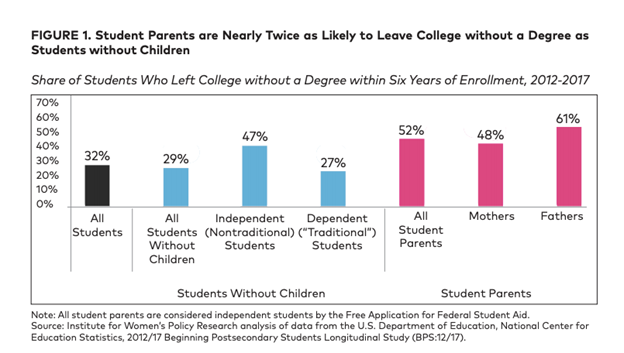 This post was written by Allison Notari, a second-year law student at Stetson University College of Law, who worked with FCAN through the Alliance for Advocacy and Philanthropy’s Community Associates Program.
This post was written by Allison Notari, a second-year law student at Stetson University College of Law, who worked with FCAN through the Alliance for Advocacy and Philanthropy’s Community Associates Program.
In March, the Institute for Women’s Policy Research released a report examining the challenges faced by student parents re-entering higher education. The report features interviews with eleven student parents, both mothers and fathers, to learn what most impacted their experience with balancing work, school, and family. This research has a wide-ranging reach as more than one in five college students are parents.
Securing affordable and reliable child care was one of the most cited issues for student parents. Few schools offered child care on campus, and some students lived in child care “deserts,” with little to no options.
“Nothing is set up for parents. Just having a space on campus for a mother or father to bring their kids, to have a place to go would be huge. Having an infrastructure for parents is essential…” – Drayton
The financial burden that student parents have is often greater than that of “traditional” students. In addition to typical school expenses, student parents are often juggling mortgages, insurance payments, and child care costs. Additionally, many aid programs have strict and extensive requirements that student parents struggled to keep up with. For example, some aid and services require strict work requirements, which may be difficult to manage for students to balance along with school and parenting. Further, small changes in income or work hours (such as switching work hours from 8-5 to 7-4) could result in a loss of eligibility or a need to turn in extensive paperwork. Their complex financial situations sometimes resulted in “making phone calls to case managers, collecting required documentation and going through the appeal process when faced with a denial” for some aid programs.
One of the most important objectives for student parents is to get their degrees quickly, so they can return to the workforce and provide for their families. However, interviewees reported that schools were tailored to “traditional” students regarding orientation schedules, class times, and academic advising. Without effective advising, student parents found it challenging to get the classes they needed to graduate.
“The program was supposed to be an accelerated program for working adults, four classes per semester broken down into eight weeks. But no one was there to help me plan out that schedule; I was there for three semesters and had no help to figure out which classes I needed to take or what I might want to do.” – Waukecha
Interviewees shared recommendations for higher education and policy leaders to best help student parents in their return to school. First, access to child care is essential to supporting student parents. In early March, the American Rescue Plan signed by President Biden provided various measures of relief for parents, including a temporary expansion of the child tax credit, which may provide financial relief for families, including student parents. This expansion leaves parents better equipped to afford child care and remain enrolled.
Providing clear information and guidance to student parents on how they can attain a degree while raising a family is crucial. Due to the many barriers they face, student parents are nearly twice as likely to leave college without a degree as students without children. However, if Florida wants to meet its state attainment goal of 60% of working-age Floridians with a high-value postsecondary degree or credential by 2030, adult students, and student parents in particular, must be included in the conversation.
For more actions policy and education leaders can take to support student parents, see the Institute for Women’s Policy Research report.
RELATED ARTICLES:
Students receive support from the American Rescue Plan Act of 2021

